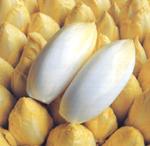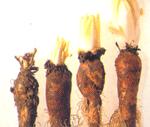| Fruits |
Vegetables
|
Witloof chicory, Cichorium intybus / Compositae
|
Note: Composition for 100 g. of fresh product Values in ( min. - max. ) format. | |
| Energy: 11.00-16.18 kcal Fats: 0.18-0.60 g Fibres: 0.90-1.26 g Fat Acids Saturated: 0.20-0.20 gPolyunsat.: 0.30-0.30 g Minerals Calcium: 21.00-25.60 mgZinc: 0.163-0.200 mg Chlorine: 25.00-25.00 mg Phosporus: 26.00-27.00 mg Iron: 0.40-0.740 mg Magnesium: 6.00-12.90 mg Manganese: 0.30-0.30 mg Potasium: 170.00-194.00 mg Sodium: 1.00-4.31 mg | Proteins: 0.50-1.30 kcal Carbohidrates: 2.34-2.80 g Liposoluble Vitamins A Retinol: 0.00-571.67 µgA Carotenoids: 120.00-3430.00 µg Liposoluble Vitamins B1 or Thiamine: 0.058-0.140 mgB2 or Riboflavine: 0.034-0.034 mg B3 or Niacine: 0.100-0.100 mg B6 or Piridoxine: 0.010-0.0484 mg B9 or Folic Acid: 5.00-8.69 mg C or Ascorbic Acid: 5.00-8.69 mg |

The witloof chicory is a vegetable used in salads, growing from chicory roots kept in warm places, protected from light. The leaves are consumed as a vegetable. They are of a white or yellowish colour, crispy, refreshing, having a slightly bitter taste. Nevertheless, this bitter taste has been reduced to a great extent in the modern varieties.
Nutrition and eating
The leaves of the witloof chicories are mainly consumed in salads or cooked and they are considered to be tonic and depurative. The root is very rich in bitter elements such as intibin, colin and inulin and potassium mineral salts, iron and calcium.
The fruit
 The witloof chicory is a vegetable used in salads, growing from chicory roots kept in warm places, protected from light. The leaves are consumed as a vegetable. They are of a white or yellowish colour, crispy, refreshing, having a slightly bitter taste. Nevertheless, this bitter taste has been reduced to a great extent in the modern varieties.
The witloof chicory is a vegetable used in salads, growing from chicory roots kept in warm places, protected from light. The leaves are consumed as a vegetable. They are of a white or yellowish colour, crispy, refreshing, having a slightly bitter taste. Nevertheless, this bitter taste has been reduced to a great extent in the modern varieties.It is also known as "Brussels chicory", "witloef" or "witloof", that means "white leaf’ in Flemish. Its bitter taste makes it a vegetable to be appropriately combined with cheese, ham or sauces.
This vegetable has a scarce energetic value since it has a low content of glucids, proteins and lipids. This is why it is used in dietary therapies. It is considered to be diuretic, digestive, re-mineraliser, tonic and an appetite stimulator.
It represents a good source of vitamin A. It also contains vitamin D and E, as well as small amounts of vitamin C, B1, B2, B3 and B6.
The calcium and phosphorus found in its composition are part of bones and teeth, and along with the potassium, they are necessary for the good functioning of nerves and muscles.
They are kept in the fridge for 5 to 7 days inside a perforated plastic bag. They are not suitable to be frozen.
Chicories are usually consumed raw, in salads, keeping all their nutritious value. They can also be eaten cooked, roasted or fried, along with mayonnaise or sauces. It is traditionally combined with blue cheeses.
Once forced, the chicory roots are also used as cattle food, becoming a forage rich in energy.
It is a vegetable of recent consumption, that has gained popularity all over the European continent. Although its culture is widely spread in France, Belgium and the Netherlands, in Spain it is hardly consumed. Nevertheless, it has experienced a certain growth in the last few years, and at present there are some modern facilities of forcing.
The plant

The witloof chicory (horium intybus var. foliosum) belongs to the family of Composites. It is a perennial plant cultivated as biennial, with tap roots and leaves arranged in rosette. After the development of a great number of leaves, generally up to 30, the photosynthates are stored in the roots, giving rise to the heart. There may be some plants with more complete limbs due to the heterogeneity of cultivars existing. There are different types of varieties with leaves of diverse shape and colours.
During the second year the plants develop a chief floral stem that reaches up to 80-90 cm high, from which lateral ramifications are born.
The inflorescence is formed by capituli. Each capitulum bears 20 flowers, generally of a blue colour, although sometimes they are white or red. Fertilization is allogamous and fruition takes place in achenes, having the shape of a straight or curved pyramid trunk. The capacity of germination of the seeds is around 3 years; in 1 g of seeds there are from 550 to 700 seeds.
During the second year the plants develop a chief floral stem that reaches up to 80-90 cm high, from which lateral ramifications are born.
The inflorescence is formed by capituli. Each capitulum bears 20 flowers, generally of a blue colour, although sometimes they are white or red. Fertilization is allogamous and fruition takes place in achenes, having the shape of a straight or curved pyramid trunk. The capacity of germination of the seeds is around 3 years; in 1 g of seeds there are from 550 to 700 seeds.
Tricks and tips
Endivias hervidas
Para evitar el amargor de las endibias, cuando se preparan hervidas, es suficiente echar al agua un terrón de azúcar
| Interempresas Media, S.L. / 2025 | [ Legal notice | Política de Protección de Datos | Política de cookies | Publicidad] |
